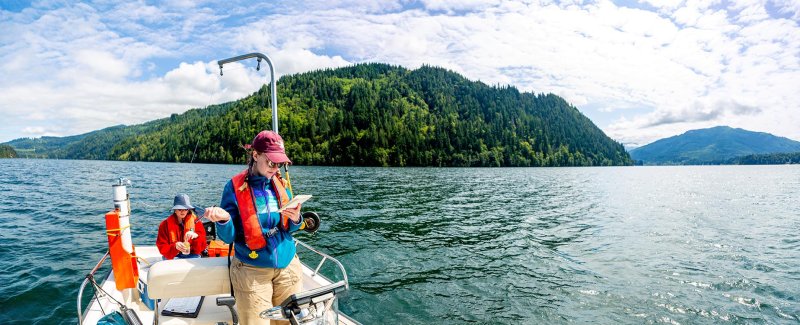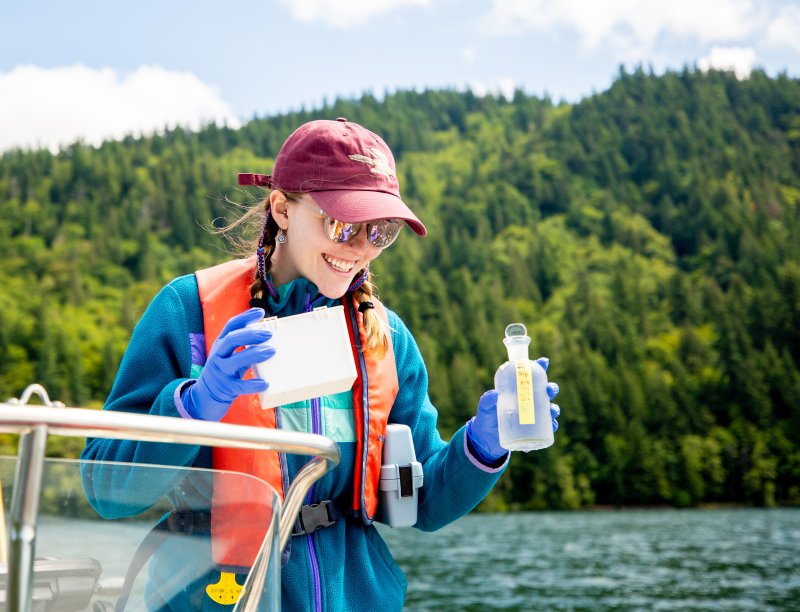Water Watchdogs: Inside the Work of WWU’s Institute for Watershed Studies
Science research can feel a bit overwhelming at times, or super specific and granular – but what Angela Strecker and the students in her lab do pulls science down to a level we can all get behind – knowing if the lake from which we draw our drinking water is healthy, or if it isn’t.
That isn’t to say that what Strecker, an associate professor of Environmental Science at Western and the director of its Institute for Watershed Studies, does is simple or mundane. Far from it. It’s just easy to connect the “why are you doing this work” with the everyday reality of most people in a way that is easy to understand.
“It’s water. We all need it to survive. And on top of that, it isn’t just any water – it's our water here in Bellingham, and our drinking supply from Lake Whatcom,” Strecker said.
Local impact
Strecker and her team of students monitor water from lakes in Whatcom, Skagit, Island, and Snohomish counties as part of the Northwest Lakes Monitoring project, which aims to track water quality – but their biggest single project remains the Lake Whatcom Monitoring project, which is supported with funding from the City of Bellingham.
Throughout the year, the team heads out on Lake Whatcom and pulls samples from a set series of testing sites at various depths. The water is brought back to the lab and analyzed for alkalinity, chlorophyll, bacteria, carbon, and compounds such as phosphates and nitrates; some of these compounds act as fertilizers and besides being undesirable in drinking water, can trigger algal blooms especially in the summer that can further degrade water quality.
The year’s data is recorded, collated, and put into an annual “State of the Lake” report that Strecker presents each year to Bellingham City Council, Whatcom County Council, and Lake Whatcom Water and Sewer District Board of Commissioners.
Lake Whatcom is something of a rarity in that it is a municipal water supply surrounded by the city – especially at its north end – that is serves, and combined with the urban pressure of pollutants and runoff also comes the impact of it being an open lake for recreation, issues which have been a political hot potato for years.
Strecker said it is her job to remain above the policy debates about the lake itself and simply present the science in as straightforward a way as possible.
In a nutshell, the lake's water quality is improving - slowly.
"It took us decades to get to this point, and will take us that long to get out of it," Strecker said. “The amount of phosphorous in the lake is no longer going up, so that is good – but we need to keep working to get that level down.”
The ongoing work is reflective of what Strecker said science should be all about.
“We are doing good science and putting it in the hands of the right people to make decisions based on it,” she said.
It took us decades to get to this point, and will take us that long to get out of it.
Angela Strecker
Institute for Watershed Studies
And just as importantly from an educational standpoint, the institute is providing students with a valuable opportunity to participate in top-notch research utilized to make policy decisions in the community where they live.
Invaluable experience
Caitlyn Steiner, a WWU Behavioral Neuroscience undergrad from Durango, Colorado who worked as a student employee for the institute last summer on the Lake Whatcom project, said the experience she gained on the lake and in the lab was vital to her understanding of how science can benefit a community.
“I know so much more about procedures in field work and ensuring you are collecting accurate samples and not disturbing the environment around you than I did before I started," she said.
“It is so interesting to learn about how the lake changes over the summer due to heat and increased human activity. The lake becomes stratified so that there are distinct layers in the lake where the dissolved oxygen and temperatures are vastly different,” Steiner said. “As a student employee for the institute, I have learned the value of working for the health of your community and the natural environment that surrounds you.”
Strecker agreed, saying the project is both a growth opportunity for students as well as a chance to put together data that makes a difference.
“There are plenty of people who are relying on this data to make decisions that impact this entire county, so it’s not lost on us how important it is to get this right,” she said.
For more information about the Lake Whatcom project or to learn more about Western’s Institute for Watershed Studies, contact Angela Strecker at angela.strecker@wwu.edu.

